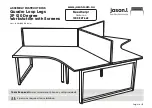
EN - ENGLISH
4
Electrical Shock Hazard
• To avoid risk of electric shock, the Generator must only be connected to supply mains with protective ground.
• Disconnect the power cord to isolate the Generator from the supply mains. Serious shock hazards may be present even with the
power switch off.
• Do not bypass the grounding prong on the Generator by using an adapter. The Generator must be properly grounded to ensure user
and patient safety. Grounding reliability can only be achieved when connected to a receptacle marked “Hospital Only” or “Hospital
Grade.”
• The output from the Generator must not be applied directly to the heart.
• Do not use in patients who have electronic implants such as cardiac pacemakers without first consulting a qualified professional
(e.g., cardiologist). A possible hazard exists because interference with the action of the electronic implant may occur, or the implant
may be damaged.
• Do not connect multiple portable socket outlets (MPSO) or extension cords to the Generator.
• Connect adapters and accessories to the Generator only when the energy is off. Failure to do so may result in an injury or electrical
shock to the patient or operating room personnel.
• Never simultaneously touch the patient and the external fuse.
• Inspect all cords, monopolar and bipolar accessory devices, and Foot Pedal for proper function and intact insulation prior to each
use.
• Use in typical commercial or hospital environment, except in RF (radiofrequency) shielded room for magnetic resonance imaging,
where the intensity of EM (electromagnetic) disturbances is high.
• Avoid HF (high-frequency) output settings where maximum output voltage may exceed rated accessory voltage.
• Activating the RF current is not permitted while inserting the electrode and during electrode replacement due to risk of burns.
• Do not use in the presence of flammable anesthetics or oxidizing gases (such as nitrous oxide (N2O) and oxygen) or in close
proximity to volatile solvents (such as ether or alcohol), as explosion may occur.
• Do not immerse the Generator in any type of liquid.
• Non-flammable agents should be used for cleaning and disinfection whenever possible.
• Flammable agents, including disinfectants, cleaning fluids, and solvents, must fully evaporate prior to HF surgical procedures. There
is a risk of pooling of flammable solutions under the patient or in body depressions such as the umbilicus, and in body cavities such
as the vagina. Any fluid pooled in these areas should be mopped up before HF surgical equipment is used. Attention should be called
to the danger of ignition of endogenous gases. Some materials, for example cotton and gauze, when saturated with oxygen may be
ignited by sparks produced in normal use of the HF surgical equipment.
• Unless a compatible monitoring neutral electrode is used with a contact quality monitor, loss of safe contact between the neutral
electrode and the patient will not result in an auditory alarm.
• Other equipment may be adversely influenced by the interference produced by the operation of HF surgical equipment. Portable
and mobile RF communications equipment can affect medical electrical equipment.
• Prevent patient contact with metal parts that are grounded or that have an appreciable capacitance to ground; e.g., operating table
supports. Use antistatic sheeting.
• Prevent patient skin-to-skin contact (e.g., between the arm and the body) when the Generator is in use. Use dry gauze between
body parts that might touch during surgery.
• When HF surgical equipment and physiological monitoring equipment are used simultaneously on a patient, any monitoring
electrodes must be placed as far as possible from the surgical electrodes. Needle monitoring electrodes are not recommended.
If needle electrodes are used, do not place in direct contact with forceps tips. Monitoring systems incorporating high frequency
current-limiting devices are recommended.
• During surgical procedures where the HF current could flow through parts of the body having a relatively small area, bipolar
techniques can prevent unwanted tissue damage.
• To prevent injury to the patient and/or user, do not connect the Generator to any item not specified as part of the system or
identified as a recommended accessory within this manual. Use of unspecified items with the system could result in excessive
leakage current. Refer to individual Instructions for Use for additional information regarding accessories or use with other devices.
SYSTEM OVERVIEW
Содержание Codman 901001ESUO
Страница 2: ...2 THIS PAGE IS INTENTIONALLY LEFT BLANK...
Страница 137: ...EL 137 Codman Codman Codman Codman Codman Integra...
Страница 138: ...EL 138 RF HF RF N2O...
Страница 139: ...EL 139 4 5 3 2 3 0 10 C 50 F 10 C 50 F IEC 60601 1 16 70...
Страница 142: ...EL 142 13 14 15 16 17 18 19 13 14 15 16 17 18 19 100 240 V 50 60 Hz T3 15 AH 250V...
Страница 143: ...EL 143 20 21 22 23 20 21 22 CUT 23 COAG...
Страница 144: ...EL 144 1 4 1 2 COAG CUT Codman Electrosurgical Generator W W BICOAG BICUT MONOCUT Monopolar Bipolar MONOCOAG 1 2 Codman...
Страница 145: ...EL 145 MONOCUT BICUT MONOCOAG BICOAG 88 CUT COAG BICUT BICOAG 00...
Страница 158: ...EL 158 Monocut Monocoag Bicut Bicoag Crescendo CF IP2X 12 5 mm 40o C 40o F 60o C 140o F 15 85 1050hPa 500hPa...





































